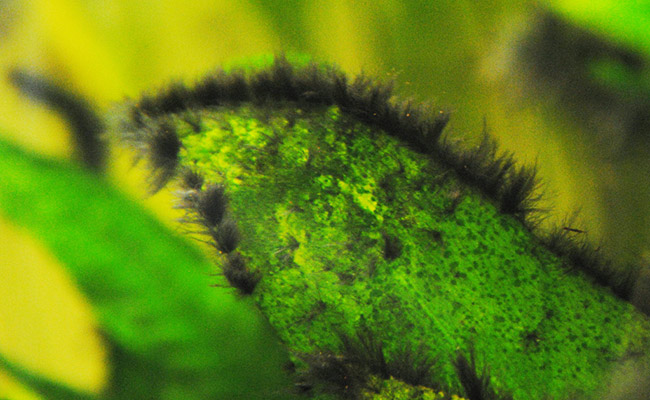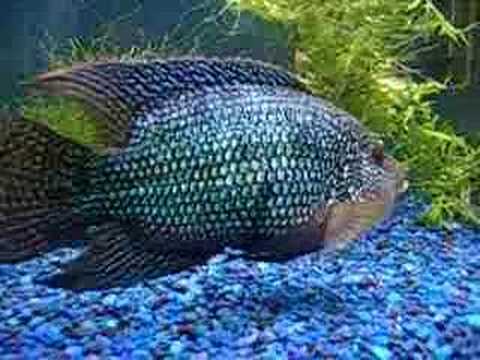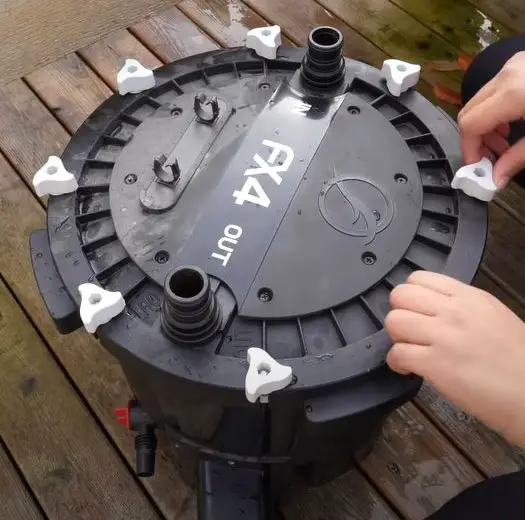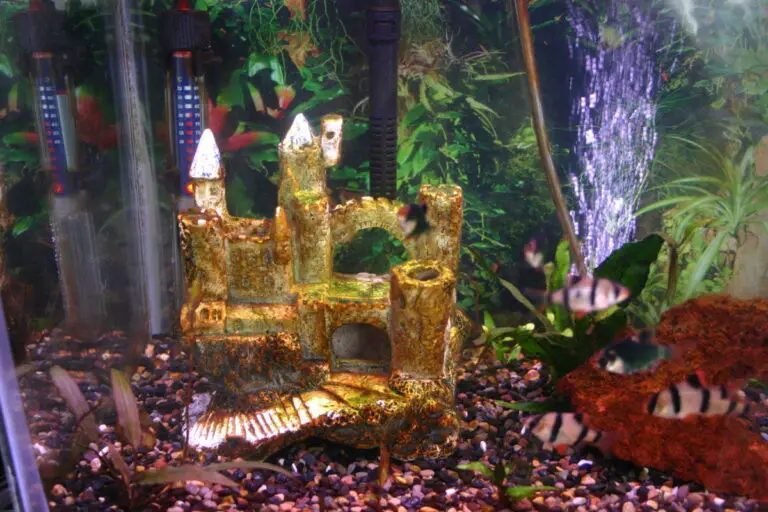How to Get Rid of Black Algae in Fish Tank?
To get rid of black algae in a fish tank, start by testing the water and adjusting it to the proper pH level. Then clean any objects or decorations in the tank with vinegar or hot water. After that, remove excess organic material like leftover food and debris from the bottom of the tank.
Next, increase aeration levels by adding an aquarium filter or air pump. Finally, use an algaecide specific for black algae to kill off any remaining colonies. Follow all instructions carefully when using chemicals in your aquarium and be sure to monitor your fish closely throughout this process for their safety and health.
- Test the water in your fish tank: Before attempting to get rid of black algae, it is important to test the water in your fish tank for ammonia, nitrite and pH levels
- Algae can thrive in an environment with high nutrient levels or low oxygen levels
- If any of these factors are out of balance, they should be corrected before attempting to remove the black algae
- Increase water circulation: Poor circulation can help promote black algae growth as it can create dead spots where nutrients accumulate and cause rapid algal growth
- Install a powerhead or filter system to increase flow throughout your tank which will help reduce nutrient accumulation and decrease chances for further algal blooms from occurring
- Reduce light exposure: Black algae needs light energy to photosynthesize and grow so reducing lighting time can limit its ability to spread throughout the aquarium while you work on removing existing colonies from surfaces such as rocks or decorations
- 4 Remove existing colonies manually: Using a soft bristled brush such as an old toothbrush, scrub down all surfaces that have been affected by black algae including glass walls, live plants, decorations etc… Vacuum up any debris created by this process using a gravel vacuum cleaner so that it does not settle back into other areas of your aquarium again later on
- 5 Treat with chemicals if necessary: After manual removal has been completed there may still be some stubborn patches remaining; treating these areas with specially formulated chemical treatments designed specifically for eliminating nuisance organisms like black algae may be necessary at this stage depending on severity
How to get rid of BLACK ALGAE FAST!
How Do You Treat Black Algae in a Fish Tank?
Black algae can be an unsightly and frustrating problem for aquarium owners. It grows in dark, moist environments, so it’s not surprising that fish tanks are prone to black algae outbreaks. Fortunately, there are a few steps you can take to get rid of this pesky organism from your tank.
First and foremost, make sure the tank is well-maintained with frequent water changes and filter cleanings. Black algae thrives in dirty water conditions and will quickly spread if given the opportunity. If possible, adjust the lighting on your tank as well; black algae loves dim light settings so increasing the brightness may help discourage its growth.
Once you’ve addressed any underlying problems causing poor water quality or inadequate light levels, try using chemical treatments specifically designed to kill off black algae such as algaecides or antibiotics (always read product instructions carefully prior to use). Finally, manual removal should be done as often as needed until all visible signs of black algae have cleared up completely; using a stiff brush or scraper tool helps remove stubborn patches from decorations and other surfaces within the tank itself. With diligent care and proper maintenance protocols in place, most cases of black algae can be eliminated relatively easily!
Is Black Algae Harmful in Aquarium?
Black algae may look unsightly in your aquarium, but it is important to understand that it isn’t necessarily harmful. In fact some types of black algae are actually beneficial for the health of your tank. Black algae usually starts appearing as a fuzzy or slimy coating on rocks and other surfaces in the tank, and can spread quickly if not removed from the tank environment.
Fortunately, proper maintenance practices can help prevent its growth. To control black algae growth you should regularly clean the glass walls and gravel bottom of your aquarium with an appropriate cleaning solution; make sure to pay special attention to areas where there is more light exposure such as near powerheads, lights or skimmers. You should also remove any debris from uneaten food or decaying plant material which can act as a nutrient source for the black algae.
Additionally keeping nitrates at low levels by performing regular water changes will reduce its growth rate significantly so it won’t become a problem in your aquarium!
What Kills Black Mold in Fish Tank?
The presence of black mold in a fish tank can be quite alarming, and it’s important to take action to get rid of it quickly. Luckily, there are several different methods for killing black mold in a fish tank or aquarium without harming the fish. The most effective way is to use bleach diluted at a ratio of one part bleach to 10 parts water.
This solution should then be used to wipe down all surfaces inside the tank, including decorations and plants as well as any rocks or gravel that may have become contaminated with the fungus. It’s also important to replace any sponges used for cleaning within the tank after they’ve been exposed to chlorine-based cleaners such as bleach, since residual traces could potentially harm your fish if not removed thoroughly. In addition, you can add an anti-fungal product such as potassium permanganate into the water itself; this will help kill off any remaining spores from the affected areas while also preventing new growth from occurring elsewhere within your setup.
Finally, make sure you keep up regular maintenance on your aquarium by regularly changing out about 25% of its water every few weeks – this will help reduce further buildup and contamination from developing inside your tank going forward!
What Eats Black Hair Algae?
Black hair algae, also known as black beard algae or BBA, is a common nuisance for aquariums. This type of algae can quickly overrun and choke out other species in the tank. Fortunately, there are several natural methods to help control it.
One of the most effective ways to keep your tank free from black hair algae is by introducing fish that feed on this type of algal growth. Commonly found grazers such as Siamese Algae Eaters, Otocinclus Catfish and various Plecostomus species will happily munch on BBA without damaging any other plants or animals in the tank. In addition to these fish species, shrimp like Amano Shrimp have also been known to graze on BBA if given enough time and access to its food source.
Finally, it’s important not to overfeed your aquarium inhabitants; an excess supply of nutrients can encourage rapid algal growth which could then become difficult (or nearly impossible) to remove without harming other aquatic life forms in the process.

Credit: fishlab.com
Types of Black Algae in Aquarium
Black algae, also known as black beard algae, is a type of aquarium algae that can cause significant problems for aquarists. It is distinguished from other types of aquatic plants by its dark green to black coloration and filamentous growth pattern. Black algae are most commonly found in tanks with poor water quality or inadequate filtration systems.
Additionally, these algal blooms may be caused by improper lighting levels or excessive nutrient availability. The best way to prevent an outbreak is to maintain good water quality and follow proper tank maintenance procedures such as regular partial water changes and removing uneaten food particles from the tank environment.
Is Black Algae in Fish Tank Bad
Black algae can be a common problem in fish tanks, but it is not necessarily bad for your tank. While the presence of black algae may mean that there are imbalances in the water chemistry or other environmental factors in the aquarium, this type of algae is generally harmless and can actually help to clean up excess nutrients from the water. In some cases, black algae may even provide shelter and food for certain species of fish.
Thick Black Algae in Fish Tank
Thick black algae in a fish tank can be caused by high levels of phosphates and nitrates. It is important to regularly clean your tank and filter to keep phosphate and nitrate levels low, as well as maintain good water quality. Additionally, adding algae-eating fish such as Plecostomus can help reduce the amount of thick black algae in your tank.
Black Beard Algae
Black Beard Algae (also known as BBA) is a type of cyanobacteria that can be found in fresh and saltwater aquariums. It appears in the form of long black filaments, which are often referred to as “beard” due to their appearance. Black Beard Algae grows quickly and is difficult to remove, making it an unwelcome guest in many tanks.
Fortunately, there are several methods for controlling its growth, including increasing water flow, reducing nitrates and phosphates levels, using ultraviolet sterilizers or chemical algaecides such as hydrogen peroxide.
Black Beard Algae Remover
Black Beard Algae Remover is a safe and effective way to remove black beard algae from your fish tank. It works by using a combination of hydrogen peroxide, sodium hydroxide, and citric acid that breaks down the cells in the algae without harming any of the other organisms or decorations in your aquarium. The product also helps to restore water quality in tanks affected by black beard algae while preventing future outbreaks.
Will Vinegar Kill Black Beard Algae
Vinegar can be used to kill black beard algae, an unsightly nuisance in aquariums. Vinegar’s acidity is effective at killing the algae without harming fish or other aquatic life. However, it is important to use vinegar with caution and follow instructions carefully so as not to harm your tank inhabitants.
Additionally, the affected area should be monitored closely after treatment, as vinegar may only temporarily reduce growth of black beard algae before regrowth begins again.
Black Algae on Plants in Fish Tank
Black algae is a common problem in fish tanks that can be caused by several factors, including poor water quality, too much light exposure, and insufficient filtration. Black algae appears as dark spots on plant leaves and it can spread quickly if not treated early. To prevent black algae from spreading further, it’s important to clean the tank regularly with good filtration and perform regular water changes.
Additionally, reducing the amount of light exposure in your aquarium may help slow down its growth.
Black Algae Eating Fish Freshwater
Black algae eating fish, such as Siamese Algae Eaters, are a popular choice for freshwater aquariums. These fish consume the excess algae growth in tanks and help keep them clean and healthy. They are an active species that will move around the tank looking for bits of algae to nibble on throughout the day.
With proper care, they can live up to 10 years or even longer!
Conclusion
In conclusion, black algae can be a difficult problem to solve in your aquarium if not addressed properly. However, by following the steps outlined in this article, you should be able to get rid of it quickly and effectively. Be sure to regularly inspect your aquarium for any signs of black algae and take preventive measures when needed.
With proper maintenance and care, you will have a healthy fish tank with no black algae!






